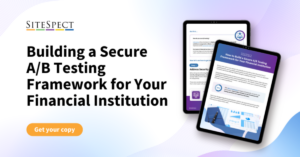5 Ways Server-Side Testing and Feature Flagging is Revolutionizing the Online Retail Shopping Experience
By Paul Bernier
April 16, 2024
Share
For retail organizations, a better understanding of shopper behavior is a top priority. Whether you already have data-driven insights or still need to uncover your customers’ shopping habits, server-side testing can help you discover actionable preferences and put the results into effect on your website, turning your understanding of user actions into a concrete strategy for conversion rate optimization.
A/B testing leads to website improvements that can boost conversion by 400%, and with the right testing tool, you’ll have the flexibility to release new features as you experiment. Feature flagging can work alongside your other testing campaigns, making it easier than ever to introduce new functionality and see the results in real time.
Server-side testing and feature flagging are opportunities not only to add new features but to increase customer engagement and satisfaction.
In the competitive e-commerce space, many companies have already adopted server-side testing technologies. Let’s take a look at five ways you can use server-side adjustments to add site upgrades, learn more about your users, and turn that data into fuel for growth.
1. Experimenting With New Features
In today’s fast-paced online retail landscape, agility is key to staying ahead of the curve. To find and resolve pain points in the shopping and checkout flow, 75% of the top 500 online retailers use A/B testing platforms.
Online retailers also face increasingly demanding consumer expectations. To keep up with the constant challenge of delivering innovative features while minimizing disruption to operations, server-side testing with built-in feature flagging proves invaluable.
Server-side testing occurs on the back end, empowering retailers to make changes and experiment with new features without the risk of browser-based issues or negative impacts on site performance. SiteSpect offers client-side and server-side testing in one unified platform and goes beyond basic feature toggling, utilizing a patented architecture to A/B test full releases, infrastructure components, app frameworks, and more.
Want to see feature updates in action?
➡️ Take the example of Liquorland, a leading liquor chain in Australia. With SiteSpect, Liquorland was able to introduce a new payment option. Through controlled rollouts and testing, Liquorland targeted specific user segments and addressed bugs before gradually expanding to a wider audience. Through the whole process, Liquorland was able to see the impact of the changes being made.
Server-side testing also offers e-commerce platforms and online retailers the flexibility to iterate quickly based on real-time data and feedback. You can test new releases on smaller segments of users before fully releasing them, reducing the risk of potential failures or negative impacts on the overall customer experience.
In the ever-changing online retail landscape, agility is not just a competitive advantage—it’s a necessity.
2. Personalization and Tailored Experiences
Enhancing customer engagement through personalized experiences is a cornerstone of many retailers’ business strategy. Here are several ways feature flagging implementations can lead to improved customer engagement:
- Dynamic Content: Enhance user engagement and relevance by leveraging SiteSpect’s audience segmentation or using segments from an integrated third-party platform. This approach allows for the delivery and testing of content tailored to user preferences, behaviors, and demographics.
- Targeted Offers: Deploy A/B tests on personalized promotions, discounts, and recommendations, increasing the likelihood of conversion and customer satisfaction.
- Adaptive Features: Receive feedback on your site functionality and customize the user experience based on data-driven indications of user preferences. Develop more intuitive navigation, site search, and checkout processes that bypass bottlenecks and drop-off points.
- Interactive Experiences: Employ server-side testing to experiment with interactive features such as product recommendations, allowing customers to actively engage with your site and provide valuable insights for further optimization efforts.
By incorporating server-side testing into your strategies with SiteSpect, your retail organization can deliver personalized experiences that resonate with customers, ultimately driving greater engagement, loyalty, and satisfaction. You’ll also avoid the technical debt of having to fully code all variations and more easily set up and run limitless tests in less time.
3. Risk Mitigation for Changes and Updates
Controlled feature releases are crucial for minimizing risks when implementing changes. With server-side A/B testing and gradual rollouts of updates to smaller groups of users, online retailers can thoroughly assess the impacts of a change before full deployment and easily roll back any change that doesn’t have the desired effect.
Organizations gain granular control over the introduction of new features, facilitating quick and seamless responses to bugs and unexpected issues. This approach also ensures continuity of operations.
SiteSpect supports flexible testing for retail organizations in several ways:
- Codeless bug fixes that can be pushed outside of release cycles
- Actionable feedback on the impact of new releases
- Session tracking
- No third-party code
- Tech stack integration
- Public and private cloud, engine API, CDN, and 100% on-premise deployment options
With flexible feature adjustments built into server-side tests, companies can closely monitor performance metrics and user feedback in one platform.
In the long run, secure and flexible experimentation strategies provide development, product, and marketing teams with the confidence to implement updates that improve customer conversion while minimizing the potential for adverse effects on user experience and system performance.
4. Continuous Optimization
Ready to optimize your conversion rates?
Server-side testing plays a pivotal role in ongoing optimization efforts. By providing businesses with the ability to iteratively refine and enhance their products or services, experimentation enables organizations to conduct experiments, test hypotheses, and introduce new features in a controlled manner.
With a fully integrated hybrid experimentation platform like SiteSpect, your organization can adopt the full range of A/B testing with the goal of elevating the user experience and ultimately encouraging your customers to convert.
Client-facing changes are a key component of website optimization, but by gathering comprehensive data on user behavior and preferences beyond messaging and images, businesses gain valuable insights into the effectiveness of their optimization efforts—and can use those insights to develop better tests and more effective user processes.
This data-driven approach allows for informed decision-making, as organizations can identify trends and areas for improvement to remain relevant, competitive, and aligned with the evolving needs and expectations of their target audience and industry.
5. Enhanced User Engagement
User engagement is a critical step along the path to conversion. As you develop site functionality and plan your next round of server-side testing campaigns, it’s important to carefully control the release of new features—and equally important to choose an experimentation platform that allows you to make quick adjustments.
Server-side optimization often targets minute site performance improvements the end user might not consciously recognize, but a seamless website can make a big difference in user satisfaction.
Seemingly small feature changes can help users find what they need, reducing bounce rates. Companies that thoroughly test algorithms and roll out features slowly will likely see more positive customer experiences and stronger conversion rates.
Continuous optimization with server-side testing helps companies respond to user needs swiftly, unlocking the potential for sustained growth in a competitive and innovative market.
As you strive to optimize your website functionality, you can simultaneously engage users, foster loyalty, and drive conversions.
Final Thoughts
In the world of online retail, server-side testing stands out as an increasingly essential part of elevating user experiences and fueling business growth. From precision-controlled feature deployments to tailored interactions and constant optimization, the advantages of server-side tests are well documented. By harnessing these techniques, retailers can adeptly address market shifts, cater to evolving consumer needs, and flourish in a dynamic landscape.
SiteSpect sets you up to experiment with features and server-side testing in one unified platform. Request your demo today to get started.
Share
Suggested Posts
Subscribe to our blog:





